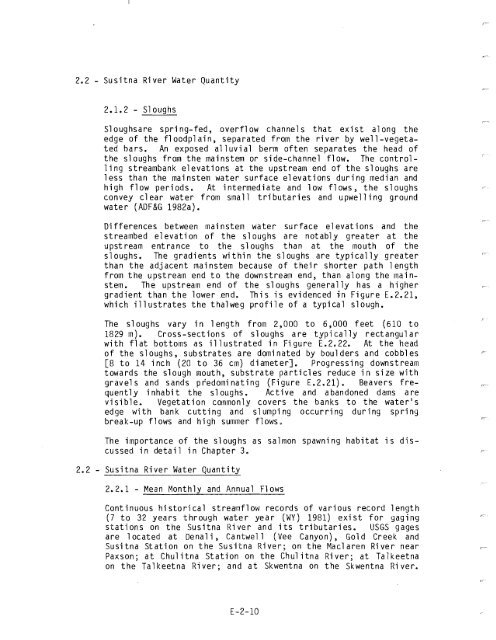before the ferc, application - Alaska Resources Library
before the ferc, application - Alaska Resources Library
before the ferc, application - Alaska Resources Library
Create successful ePaper yourself
Turn your PDF publications into a flip-book with our unique Google optimized e-Paper software.
2.2 - Susitna River Water Quantity<br />
2.1.2 - Sloughs<br />
Sloughsare spring-fed, overflow channels that exist along <strong>the</strong><br />
edge of <strong>the</strong> floodplain, separated from <strong>the</strong> river by well-vegetated<br />
bars. An exposed all uvi al berm often separates <strong>the</strong> head of<br />
<strong>the</strong> sloughs from <strong>the</strong> mainstem or side-channel flow. The controlling<br />
streambank elevations at <strong>the</strong> upstream end of <strong>the</strong> sloughs are<br />
less than <strong>the</strong> mainstem water surface elevations during median and<br />
high flow periods. At intermediate and low flows, <strong>the</strong> sloughs<br />
convey clear water from small tributaries and upwelling ground<br />
water (ADF&G 1982a).<br />
Differences between mainstem water surface elevations and <strong>the</strong><br />
streambed elevation of <strong>the</strong> sloughs are notably greater at <strong>the</strong><br />
upstream entrance to <strong>the</strong> sloughs than at <strong>the</strong> mouth of <strong>the</strong><br />
sloughs. The gradients within <strong>the</strong> sloughs are typically greater<br />
than <strong>the</strong> adjacent mainstem because of <strong>the</strong>ir shorter path length<br />
from <strong>the</strong> upstream end to <strong>the</strong> downstream end, than along <strong>the</strong> rnai nstem.<br />
The upstream end of <strong>the</strong> sloughs generally has a higher<br />
gradient than <strong>the</strong> lower .end. This is evidenced ;In Figure E.2.21,<br />
which illustrates <strong>the</strong> thalweg profile of a typical slough.<br />
The sloughs vary in length from 2,000 to 6,000 feet (610 to<br />
1829 m). Cross-sections of sloughs are typically rectangular<br />
with fl at bottoms as ill ustrated in Fi gure E.2.22. At <strong>the</strong> head<br />
of <strong>the</strong> sloughs, substrates are dominated by boulders and cobbles<br />
[8 to 14 inch (20 to 36 cm) diameter]. Progressing downstream<br />
towards <strong>the</strong> slough mouth, substrate particles reduce in size with<br />
gravel s and sands predomi nating (Figure E.2.21). Beavers frequently<br />
inhabit <strong>the</strong> sloughs. Active and abandoned dams are<br />
visible. Vegetation commonly covers <strong>the</strong> banks to <strong>the</strong> water's<br />
edge with bank cutting and slumping occurring during spring<br />
break-up flows and high summer flows.<br />
The importance of <strong>the</strong> sloughs as salmon spawning habitat is discussed<br />
in detail in Chapter 3.<br />
2.2 - Susitna River Water Quantity<br />
2.2.1 - Mean Monthly and Annual Flows<br />
Continuous historical streamflow records of various record length<br />
(7 to 32 years through water year (WY) 1981) exist for gaging<br />
stations on <strong>the</strong> Susitna River and its tributaries. USGS gages<br />
are located at Denali, Cantwell (Vee Canyon), Gold Creek and<br />
Susitna Station on <strong>the</strong> Susitna River; on <strong>the</strong> Maclaren River near<br />
Paxson; at Chulitna Station on <strong>the</strong> Chulitna River; at Talkeetna<br />
on <strong>the</strong> Talkeetna River; and at Skwentna on <strong>the</strong> Skwentna Ri ver.<br />
E-2-10
















